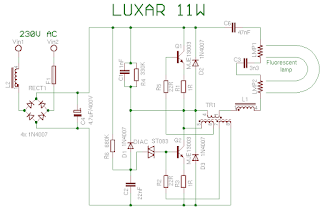Rangkaian Voltage Source Resonant
Rangkaian ini paling banyak dipakai oleh berbagai industri ballast elektronik saat ini. Tegangan AC sebagai tegangan suplai disearahkan dengan mengggunakan bridge DR dan akan mengisi kapasistor bank C1. C1 akan menjadi sumber tegangan DC untuk tabung lampu TL. Kemudian sebuah input filter dibentuk untuk mencegah rangkaian dari tegangan transien dari tegangan suplai PLN dan melemahkan berbagai sumebr noise EMI (Electro Magnetic Interferrence) yang dihasilkan oleh frekuensi tinggi dari tabung lampu TL. Filter input ini dibentuk dengan rangkaian induktor dan kapasitor. Blok diagram rangkaian dapat dilihat pada gambar berikut:
Blok diagram rangkaian Voltage Source Resonant
Input filter ini harus mempunyai spesifikasi yang baik karena harus dapat mencegah interferensi gelombang radio sebagaimana di Amerika, input filter ini harus mempunyai sertifikat FCC. Frekuensi resonansi yang dihasilkan dapat ditentukan dengan menggunakan persamaan:
Pada saat rangkaian dihidupkan maka tabung TL akan mempunyai impedansi yang sangat besar sehingga C4 seakan-akan seri dengan L dan C3 sehingga didapatkan persamaan di atas. Resonansi yang dihasilkan ini mempunyai tegangan yang cukup besar agar dapat mengionisasi gas yang berada di dalam tabung lampu TL tersebut. Kondisi ini akan menyebabkan kondisi starting yang tiba-tiba sehingga dapat memperpendek umur dari filamen karena filemen belum mendapatkan pemanasan yang cukup untuk mengemisikan elektron. Kondisi ini ditentukan oleh keadaan osilatornya. Pada saat starting up ini pula terdapat arus peak yang sangat besar, sebesar 4 kali arus steady state. Oleh karena itu harus dipilih transistor yang mempunyai karakterisktik arus kolektor sebesar 4 x arus steady yaitu sekitar 2.75A. Arus steady besarnya sekita 0.75A. Sehingga Q1 dan Q2 harus mampu melewatkan arus sebesar 2.75A. Ketika tabung TL telah terionisasi dengan penuh maka impedansinya akan turun menjadi ratusan ohm saja sehingga akan membuang muatan pada C4. Kondisi ini akan menggeser frekuensi resonansi ke nilai yang ditentukan oleh C3 dan L. Energi yang sedang digunakan tersebut sekarang lebih kecil begitu pula dengan tegangan di antara elektroda-elektrodanya menjadi kecil pula. Kondisi ini mengakhiri kondisi startup dari lampu TL ini.




















